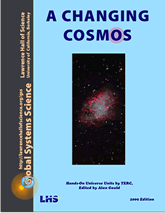A Changing Cosmos

A Changing Cosmos is the latest edition of the Hands-On Universe (HOU) astronomy curriculum series. It is a compilation in a single book as the “Best” of the seven original HOU high school curriculum books developed by TERC*.
See also: Solar System Science.
Contents
- These investigations use image processing software and all images needed for them are contained in the jpg image set for A Changing Cosmos.
Solar System Science
Originally titled Hands-On Solar System (HOSS), Solar System Science was designed as a middle school curriculum in the Hands-On Universe project. Students use images from professional telescopes along with image processing software developed for use in the classroom to learn key concepts in astronomy, mathematics, and technology. The components are:
- Solar System Science Student Book (3 Mb PDF),
- Teacher Guide (1.4 Mb PDF),
- One of these image processing apps
- JS9 (online app) – https://js9.si.edu
- JS9-HOU (online app)
https://hou-js9plugins.educontinuum.org - SalsaJ available from European HOU site
- Images (.zip download)
Activity: What is it? How far is it?
A good reference openstax textbook to accompany this course is Astronomy (textbook online) by Andrew Fraknoi, David Morrison, and Sidney Wolff – https://openstax.org/details/books/astronomy-2e. See also group resources for openstax Astronomy – https://oercommons.org/groups/openstax-astronomy/1283/?__hub_id=27.
* The seven books of the original TERC high school Hands-On Universe curriculum:
- Introduction to Image Processing—how to use the HOU Image Processing Software
- Finding Features—including a Browser’s Guide to the Universe.
- Measuring Size—Use the pixel plate scale to measure a lunar crater; track Jupiter’s moons; calculate mass of Jupiter.
- Measuring Color—colors of stars, the HR diagram, and how stars evolve according to their mass.
- Measuring Distance—Learn how the cosmological distance ladder is used to determine the distance to far away objects.
- Measuring Brightness—Learn about photometry — measurement of light from a celestial object.
- Searching for Supernovae—See how astronomers find supernovae — exploding stars.

